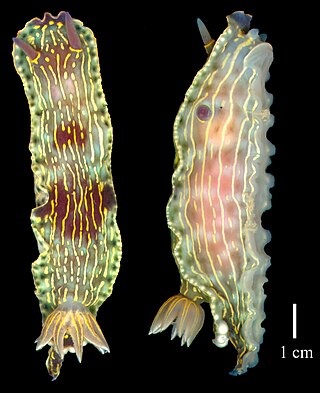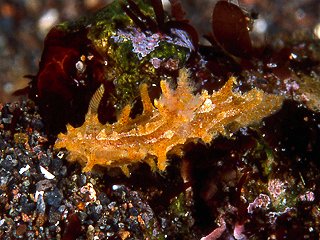
Fiona pinnata, common name Fiona, is a species of small pelagic nudibranch, a marine gastropod mollusk in the superfamily Fionoidea. This nudibranch species lives worldwide on floating objects on seas, and feeds mainly on barnacles, specifically goose barnacles in the genus Lepas.

Halgerda stricklandi is a species of sea slug, a dorid nudibranch, a shell-less marine gastropod mollusk in the family Discodorididae.

Halgerda carlsoni is a species of sea slug, a dorid nudibranch, shell-less marine gastropod mollusks in the family Discodorididae.

Oxynoe viridis is a species of small sea snail or sea slug, a bubble snail, a marine gastropod mollusk in the family Oxynoidae.

Felimare bayeri is a species of colorful sea slug or dorid nudibranch, a marine gastropod mollusk in the family Chromodorididae. It was described by Eveline and Ernst Marcus in 1967.
Aiteng ater is a species of sea slug, a marine gastropod mollusc in the family Aitengidae. The specific name ater is from the Latin language and means black, in reference to the appearance of the slug on the mud.

Thorunna daniellae is a species of sea slug, a dorid nudibranch, a shell-less marine gastropod mollusc in the family Chromodorididae.
Plocamopherus lemur is a species of sea slug, a nudibranch, a shell-less marine gastropod mollusk in the family Polyceridae.
Plocamopherus pecoso is a species of sea slug, a nudibranch, a shell-less marine gastropod mollusk in the family Polyceridae.
Plocamopherus margaretae is a species of sea slug, a nudibranch, a shell-less marine gastropod mollusk in the family Polyceridae.
Kaloplocamus dokte is a species of sea slug, a nudibranch, a shell-less marine gastropod mollusk in the family Polyceridae.

Kaloplocamus peludo is a species of sea slug, a nudibranch, a shell-less marine gastropod mollusk in the family Polyceridae.
Kaloplocamus maru is a species of sea slug, a nudibranch, a shell-less marine gastropod mollusk in the family Polyceridae.

Calmella cavolini is a small aeolid, with a maximum length of 12mm. It has smooth elongate rhinophores, oral tentacles, and angular anterior foot corners. Cerata, with a common stalk each, are arranged in groups. The front 3 ceratal clusters, which are on each side, are oppositely arranged but the posterior 3 ceratal clusters are arranged alternately. The color of digestive gland duct is bright red but the apical cnidosac is white in color. The jaw plates are purplish red and they show through each side of the slug's head as a reddish color spot. It was reported that it feeds on the hydroid, Eudendrium.
Pleurobranchus varians is a species of sea slug, a sidegill slug, a marine gastropod mollusc in the family Pleurobranchidae.
Phyllidia madangensis is a species of sea slug, a dorid nudibranch, a shell-less marine gastropod mollusk in the family Phyllidiidae.

Bathyhedyle boucheti is a species of panpulmonate slug, a deep-sea dwelling gastropod native to the continental slope off the coast of Mozambique. It is the first ever such panpulmonate slug to be discovered at such depths. It is the only known member of its family group. Its radular formula is 1.1.2.
Kankelibranchus incognitus is a species of sea slug, a nudibranch, a shell-less marine gastropod mollusc in the family Polyceridae.
Kankelibranchus alhenae is a species of sea slug, a nudibranch, a shell-less marine gastropod mollusc in the family Polyceridae.

Sphiximorpha willistoni, or Williston's wasp fly, is a rare species of syrphid fly found in eastern North America. It is a strong wasp mimic. Hoverflies can remain nearly motionless in flight. The adults are also known as flower flies for they are commonly found on flowers, from which they get both energy-giving nectar and protein-rich pollen. Larvae in this genus are found in sap runs of trees.









